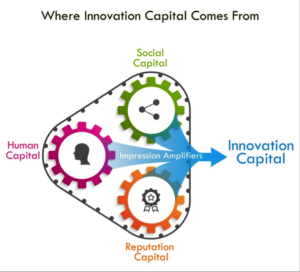
February 20, 2019
In the digital world,
successful leaders work hard to increase their innovation capital

The myriad of new disruptive digital technology innovations has raised the leadership bar for success. Companies can no longer pay lip service to innovation as an addendum to their business growth strategy if they want to compete as viable digital enterprises.
Leaders from the C-Suite on down throughout the organization now have to cultivate and develop their innovation leadership skills to influence others to support funding and development for next generation products, services and new businesses ideas.
A research study from the Harvard Business Review identified and measured four essential leadership qualities as proxies for creating innovation capital:
- Personal reputation for innovation – who you are
- Social connections and networks – who you know
- Track record for value creation – what you are known for
- Investor expectations for future value creation – innovation premium
Cultivating and developing these leadership qualities and leveraging them to deliver market leading value creation and customer experiences is very hard work. It requires an open minded, forward thinking approach to new ways of doing things combined with an ability to make innovation part of an organization’s cultural DNA.
As Marc Benioff, CEO at Salesforce, says “I can’t do it all. I don’t have all the ideas. That isn’t my job. My job is to build a culture of innovation. That’s something that we try to enforce. We encourage it. We value it. We notice it. We compensate for it. We require it.”
Building a path to the future starts with letting go of the past

The only thing harder than predicting the future is building a successful path to it. In KPMG’s Global CEO Outlook 2016 survey of 400 CEOs they documented these results:
- 85% admit vulnerability about the amount of time they spend strategizing about forces of disruption and innovation
- 80% are concerned that their existing products and services will not be relevant in 3 to 5 years’ time
- 70% believe their organizations’ cultures do not encourage risk-taking and safe-to-fail environments
As my brother, Geoffrey Moore, documented in his book Escape Velocity, most companies struggle to free their future from the pull of their past. The single biggest challenge facing CEOs and other C-Suite leaders in well established companies is how to find the right balance between funding the businesses they have versus making significant enough investments in next generation businesses so they can deliver material new revenues and profits.

A look at the automotive market provides a compelling business case for letting go of the past. A decade ago, Chrysler was the weakest of the three Detroit automakers and barely staved off collapse before merging with Fiat. Three years ago, then Fiat Chrysler CEO, Sergio Marchionne, led a company wide initiative to stop making passenger cars entirely, where both GM and Ford were losing money, and focus resources on the high-margin sport utility and truck market.
In 2018 Fiat Chrysler’s sales in the U.S. increased 9% while sales fell at GM, Ford, Toyota and other big manufacturers. GM has now announced the closing of three passenger car and two engine factories and Ford said it will no longer make popular sedans like Fusion, Focus and Taurus.
Walking away from passenger cars, the bedrock of the automotive industry, not only took a leader with foresight but also the courage to free his company’s future from the pull of its past.
As I’ve written about in a previous blog, when Satya Nadella took over as CEO of Microsoft he embarked on a transformation initiative to reboot each of the companies core businesses. He pivoted the Office Business from an on-premise, on-desktop business model to a cloud-first, mobile-first model that was showing modest growth potential competing with Amazon Web Services.
The business was generating $5 billion in revenues and Satya set a three year goal of $20 billion. Microsoft surpassed that goal 9 months ahead of schedule and is now the fastest growing cloud services provider in the category. It’s stock price more than tripled in that time period validating the “innovation premium” the market gives to companies that can meet investors expectations for future value creation.
Satya believes “a leader must see external opportunities and the internal capability and culture – and all the connections among them – and respond to them before they become obvious parts of conventional wisdom.”
He has stated that there are three essential leadership attributes necessary to successfully build a new path forward:
- The ability to create clarity when none exists
- A knack for sparking energy
- An ability to succeed in an over-constrained space
A framework and process to increase your track record for value creation

The hard truth for most companies is that well over 70% of their new product and business innovation investments generate little or no ROI. While there are numerous reasons given for this lack of success, I think it stems from not having a business innovation framework that distinguishes between different types of innovations and the outcomes they are designed to deliver as shown on the chart above.
Over the past two years, I’ve been working with senior business leaders and business innovation teams using this framework and process to prioritize and manage a portfolio of innovation projects. The key success factor has come from building a balanced portfolio of Sustaining innovations and Disruptive innovations that are aligned with the company’s business growth goals and financial metrics.
Each innovation initiative is first segmented using the following questions:
- Is it a sustaining or disruptive innovation?
- Is it enabling systems productivity and cost optimization? – Productivity Zone
- Is it increasing business unit performance and revenue growth? – Performance Zone
- Is it enabling a business model transformation? – Transformation Zone
In addition, instead of using resource capacity and budgeting constraints to make prioritization decisions, we deploy the following three questions:
- Should we do it? Does it align with and support critical business outcomes?
- Can we do it? Do we have the relevant skills, capabilities and tools to achieve the desired outcome?
- Did we do it? Do we have the right metrics to measure the achieved outcome vs. the desired outcome as shown on the slide below?

This new approach moves project prioritization decisions from a budget exercise to a business value creation exercise that leverages business innovation as the new competitive imperative.
The market rewards sustainable value creation with an innovation premium

A 2017 McKinsey study documented that those companies who aggressively pursue business innovation through digital technology have a 12% ROI vs. those who just invest to protect their core business who have a 6% ROI.
A Harvard Business School study showed that leading digital companies generate better gross margins, better earnings, and better net income than organizations who have not yet adopted a digital-first business growth strategy. Early digital adopters delivered a three-year gross margin of 55% vs. 37% for digital laggards.
As the two charts below illustrate, the market rewarded Salesforce and Microsoft for continuous value creation with an innovation premium that delivered significant increases in their stock prices.


As always, I am interested in your comments, feedback and perspectives on the ideas put forth in this blog. Please e-mail them to me at pdmoore@woellc.com. And, if this content could be useful to someone you know please share it here:



